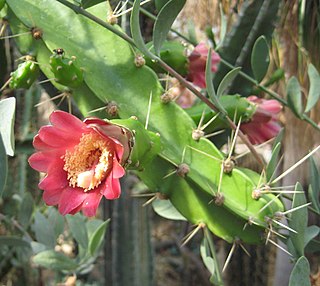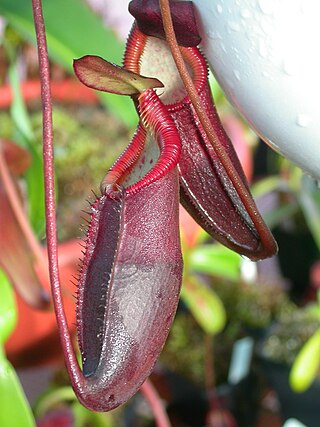
Cerbera is a genus of evergreen small trees or shrubs, native to tropical Asia, Australia, Madagascar, and various islands in the Indian Ocean and the western Pacific Ocean.

Cistus creticus is a species of shrubby plant in the family Cistaceae. Though it usually has pink flowers, of 4.5–5 cm diameter, this species is very variable. It is widely known as a decorative plant. It is frequently called "Cistus incanus".

Calymmanthium is a monotypic genus of primitive tree-like cacti from northern Peru. The only species is Calymmanthium substerile. It belongs to the tribe Lymanbensonieae. Calymmanthium is absolutely unique among flowering plants in the mode of its floral development. The young flower is completely encased within the plant's stem until it is fully developed, at which time a crack develops in the stem, allowing pollinators access.

Nepenthes diatas is a tropical pitcher plant endemic to Sumatra, where it grows at an altitude of 2,000–2,900 metres (6,600–9,500 ft) above sea level.

The Cardueae are a tribe of flowering plants in the daisy family (Asteraceae) and the subfamily Carduoideae. Most of them are commonly known as thistles; four of the best known genera are Carduus, Cynara, Cirsium, and Onopordum.

Cistus monspeliensis is a species of rockrose known by the common name Montpellier cistus. It is native to southern Europe and northern Africa, in the Mediterranean forests, woodlands, and scrub ecosystems of matorral—maquis shrublands.

Hedysareae is a tribe of plants in the subfamily Faboideae. Hedysareae species have loments, a type of modified legume that breaks apart at constrictions occurring between the segments of the seeds.

Anacardioideae is a subfamily of plants in the family Anacardiaceae.

Cistus laurifolius, commonly called laurel-leaf cistus, laurel-leaved cistus or laurel-leaved rock rose, is a species of highly branched flowering evergreen shrub native to some areas around the Mediterranean.

Orchideae is a tribe of orchids in the subfamily Orchidoideae. Historically, it was divided into 2 subtribes, Orchidinae and Habenariinae. The subtribe Orchidinae alone contains about 1,800 species. However, although some phylogenetic studies have established the monophyly of the subtribes, the generic boundaries are unclear, with many genera as traditionally circumscribed being paraphyletic or even polyphyletic. Species of genera such as Habenaria and Platanthera have been placed into both subtribes. A 2017 molecular phylogenetic study found that both subtribes did form clades, but did not formally recognize Habenariinae, because of missing genera and uncertainty over generic boundaries. The Asian species of Orchideae, in particular, have been subject to repeated changes of generic placement from 2012 onwards.

Spermacoceae is a tribe of flowering plants in the family Rubiaceae and contains about 1346 species in 57 genera. Its representatives are found in the tropics and subtropics.
Cistus asper is a shrubby species of flowering plant in the family Cistaceae with purple-pink flowers. It was first described in 2005 and is endemic to El Hierro in the Canary Islands.
Cistus palmensis is a shrubby species of flowering plant in the family Cistaceae.

Cistus parviflorus is a shrubby species of flowering plant in the family Cistaceae.

Cistus populifolius is a shrubby species of flowering plant in the family Cistaceae.
Cistus pouzolzii is a shrubby species of flowering plant in the family Cistaceae.

Cistus sintenisii is a shrubby species of flowering plant in the family Cistaceae. It was named in honor of Paul Sintenis.

Cistus symphytifolius is a shrubby species of flowering plant in the family Cistaceae. It is endemic to the Canary Islands".
Meso-Papilionoideae is a monophyletic clade of the flowering plant subfamily Faboideae that includes the majority of papilionoid legumes. This clade is consistently resolved in molecular phylogenies. It contains many agronomically important genera, including Arachis (peanut), Cicer (chickpea), Glycine (soybean), Medicago (alfalfa), Phaseolus, Trifolium (clover), Vicia (vetch), and Vigna.
Sulla is a genus of flowering plants in the legume family, Fabaceae. It belongs to the subfamily Faboideae. It ranges from Siberia to the Mediterranean and North Africa.















